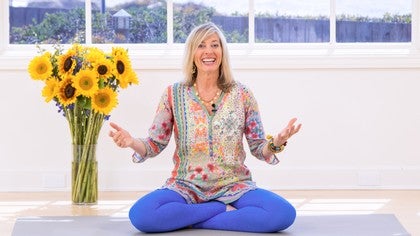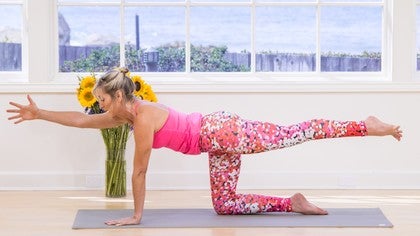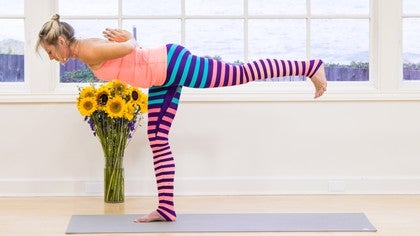Description
About This Video
Transcript
Read Full Transcript
(waves lapping) Namaste. I'm very exited to present this work to you, and this is work that I've been developing for quite some time. I've been practicing very consistently for, I don't even know, probably 24 years, I believe. 24 years, and in that time my approach was to learn as much as I possibly could from as many teachers as I could because I kept feeling as though I was getting close to something, but I was unable to touch it. And so I've read a lot, and I've studied, and in the process of doing that I heard early on I believe, that there were 84 thousand postures, and I first asked myself, well why 84 thousand?
And how would I possibly be able to learn 84 thousand? Does anybody know what they are? Is this a metaphor for something else? What is the significance, and how does it relate to my practice in particular? And then I discovered along the way that often, the 84 thousand postures were synthesized down to 84 postures, and in the last few years some research has come out about the origin of 84 postures, and where that began in India and in Nepal, as early as about the 17th and 18th century, some of the early texts point to 17th century, but we start seeing drawings in the 18th, 19th century, and they're beautiful drawings, and in fact I was lucky enough to go to Northern India and photograph a set of those 84 postures, but what I discovered was many of those postures are seated, they're seated postures, because they're preparing the body for meditation.
And while some of them that we would recognize like this posture, in fact, or Baddha Konasana, are evident in the practice, almost, well, actually, all standing postures were not there. And many of the postures that I did every day were not there. So I've been looking at how to, how to stay true to a tradition that is, long standing, that I have deep respect for, and to match it with the needs of my students, who usually have about an hour and a half, if they're lucky, to practice every day. And they have multiple reasons for why they're practicing. They want some relief, because they're really busy and stressed, they want to open their body, strengthen their body, work on balance, become a little more flexible, and a little more at ease in their body, and they want to be able to feel (chuckling) good.
Don't we all want to be able to feel good? And so what I began to see was that the needs of the contemporary yoga practitioner are distinct, in some respects, although probably the feel good part, is very, very, similar. What kind of good, feel good, may be a little distinct, but that the two were a little different, and so I wanted to create a method that has it's roots, some old, old, roots, while at the same time contributing to the modern yoga practitioner. So what I've done is I have looked at a variety of 84 posture schematics, because it's been done several times but the postures change, and I've looked at my own practice and the practices of contemporary yoga teachers, and I've also looked at functional anatomy, and ways in which we're seeing that the bio mechanics of the body need to be engaged on a regular basis. And I've come up with 84 postures, and I call them seed postures, and from each of these 84, all of which, if you've practiced yoga regularly, you will recognize.
The body can move in a variety of ways, but each one represents, like a seed, from which so many things can happen. I've divided up the series so we start with really very simple movements that open the joints, really useful in the morning, also happen to be within Surya Namaskar, or sun salutations, and then we move on to postures that involve big, wide legged movement for the hips and pelvic floor, because the standing postures are so essential to the lifestyle that we have, which for most of us is sitting. Those postures are necessary for anything else to happen above the waistline, quite frankly, any kind of opening. And then we move on to a balance series, we all know that balance is really essential, especially as we get older. And then the core, the mid body, which tends to just dissolve and sort of get lost as we get older, it's the center from which we move, to opening outward, but opening outward intelligently, and up the spine, to folding forward, but folding forward almost like origami, knowing how to fold forward, how to create seated twists in an order, in a natural order that's intelligent, to turning the body upside down.
And turning the body upside down for people who are just brand new to yoga, or have issues with inverting, we start with very simple ways to do that, and then we move into more complex asanas as we go. All of these are geared toward arriving in, and, I love this term, open awareness, where whatever we came in with when we sit down on the mat, and we begin our practice, we observe all of this stuff going on, often from our day, emotions we may be carrying, beliefs we have about the way things are, and through this movement we begin to, all of a sudden, realize oh, that's right, that's not who I am, and this spaciousness is created. I mean what a gift that is. (laughing) Its a beautiful thing, the spaciousness is created where we can see it and have room for the river of thoughts, and feelings, and emotions, that occur in the body, and that no matter who we are, we're going to have, and we're probably going to have those for the rest of our lives, but the effect that they have on us shifts, through practice. So that's the intent, and I want to mention that, one of the things that I learned about early yoga, early yoga had, well, depending on which tradition you ascribe to, had asana, it had pranayama, the breath work, it had japa, the repetition of mantra, and often seals, or mudras, where the body becomes a mudra, the whole body, built in.
And so what they're doing there is they're uniting body, breath, and mind, and we hear that all of the time, but in contemporary practice, often what happens is, the uniting of particularly the mind gets left out of the practice. A good yoga class, you're gonna find the breath and the body working pretty well together, but then what are we doing with this? And so, one of these series also addresses how to use the mind well, so that we really can create the sense of absorption, samadhi, that's another term that's often used, where that open awareness becomes our potential. And I've used the growing your practice as a metaphor for these, this evolution through the seed postures, because I feel, and it's been in my experience, that with these ingredients, it's like you pull out all the ingredients from your frigerator, and you're gonna make a fantastic meal, with the right ingredients, that's possible. And what I hope to do here, is to present you with all of the ingredients that you need for transformation and happiness.
Enjoy.






You need to be a subscriber to post a comment.
Please Log In or Create an Account to start your free trial.